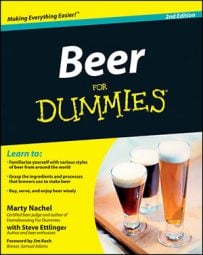Even though all other alcoholic beverages are required to clearly list alcohol content on their labels, listing any indication of strength, including percentage of alcohol (unless the beer has no alcohol at all), was prohibited for beer labels until 1996. For years, the government had been afraid that people might sell or buy beer based on strength alone. (Why didn’t the same reasoning apply to wine or spirits?)
The vast majority of beers from around the world have alcohol contents of 4 to 6 percent alcohol by volume (for example, Budweiser has 5 percent). Many beers may contain as much as 7 or 8 percent, and a select few contain alcohol levels equivalent to quality wines, which are about 12 to 14 percent.
The more common method of listing alcohol content in beer is by actual percentage of volume, which is the law in the United Kingdom and Europe. In the United States, it had been the big brewers’ custom to note alcohol by weight. Of these two methods, alcohol by volume is easier to understand because you buy beer by volume, and today, the vast majority of brewers list alcohol contents by volume.
Why is the weight method used? Because alcohol weighs less than water, beer, and many other liquids and, therefore, appears to be lower when comparative measurements are made. In English measure, a pint of water, for example, weighs 1 pound (actually, a fraction of an ounce over). A pint of alcohol, on the other hand, weighs only 0.79 pound. So a beer with an alcohol content of 3.2 percent by weight is actually 4 percent by volume. A beer that is 4 percent by weight is actually 5 percent by volume. To figure it out yourself, convert an alcohol-by-weight reading to its alcohol-by-volume equivalent by multiplying by 1.25. To convert an alcohol-by-volume reading to its alcohol-by-weight equivalent, multiply by 0.80. Fun, huh?
Some internationally published beer writers give both measurements in their beer reviews. Read labels and menus carefully and remember that figures for weight are lower than those for volume. You may be consuming much more (or less) alcohol than you think.
Europeans are accustomed to seeing some indication of the alcohol content in their beers, whether or not it’s accompanied by a figure:
In Germany, beer bottle labels are likely to contain one of the following three legal strength designations: schankbier (light), vollbier (medium), or starkbier (strong).
Belgium has four categories of beer strength, ranging from Catégorie III (weakest) and moving up through Catégories II and I, ending with Catégorie S, for strong.
The French have to be different, of course. They invented their own strength measure, called degrees Régie, which they use to measure beers ranging from bière petite (the lightest) through bière de table, bière bock, bière de luxe, bière de choix, and bière spéciale (the strongest).

